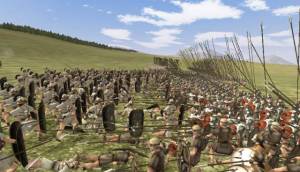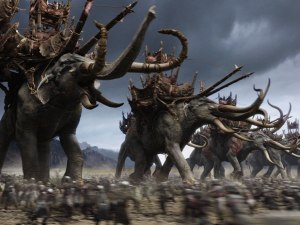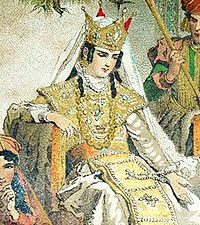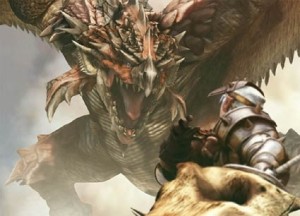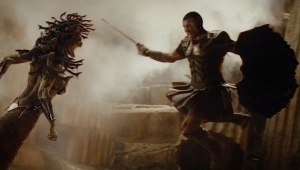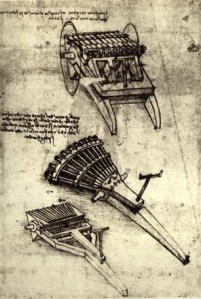Pyrrhic Victory. (n) A victory that is offset by staggering losses.
Zach – Today we’re going to be looking at the origin of the term “Pyrrhic Victory.” Not surprisingly it comes from a guy named Pyrrhus, a Greek king that tangled with the early Roman Republic. We’re going to see a classic Greek phalanx going up against a Roman legion. Clash of the Titans!
To help us get to the bottom of this topic, we brought in a panel of historical experts. With me is my co-host, Anna Komemne: Byzantine princess and first woman historian. Then we have Hua Mulan, woman soldier of ancient China. Next we have Gaspar Correia, Conquistador and was voted in his high school yearbook as “least reliable historian ever.” Then we have …what’s she doing here? We have Boudica, Britain barbarian woman warrior. Then we have Charles Martel, Frankish warlord who earned the nickname, “the Hammer.” And lastly we have St. Olga of Kiev, first Russian Christian with a mean streak longer than the great wall of China.
Anna – Let us get started, shall we?
Martel – I say we start with the makeup of the two opposing forces.
Anna – Lovely suggestion. Perhaps you can tell us about the Romans at this time.
Martel – King Pyrrhus invaded Italy in 280bc. At this time the Romans had a republic. The legions were comprised of citizen soldiers and each soldier bought their own equipment. Much of the military was based off of Rome’s former enemies turned reluctant ally: the Samnites. The military was subject to the Roman Senate who elected two Consuls. These were generals that shared command, taking turn every other day. Perhaps not the best system. I could get into more detail but I find the Republic system of authority to be convoluted and confusing. The lower class citizens generally formed the heavy infantry of the legion and the higher class were the “Equites” or “Equestrians” the cavalry. They were the ones that could actually afford the war horses. Each soldier equipped themselves but the general kit for a legionnaire was a helmet with cheek guards, either a round shield or curved oval one, some short javilins, a long spear and a little sword they stole from the Spanish: the gladius.

Unlike a phalanx they fought in smaller, more mobile blocks of infantry and instead of long pikes, they used short swords and thrown “pilum,” short javelins.
Boudica – Amazing. these Roman dogs started off with free citizens that volunteered for one year of service and went to forcing conquered barbarians to do all their fighting.
Gaspar – The legions of the Republic also fought in a checkerboard pattern that we can’t figure out how they did it. We have no idea how they worked with huge gaps in their front line.
Mulan – Gaspar. Stop making stuff up. That makes no sense whatsoever.
Zach – No, for once Gaspar is telling the truth. They fought like that and we have no idea how they did it or way.
Gaspar – It’s simple really. The plasma cannons they used were too dangerous to fire with units to either side of them. the Greeks at this time were using standard laser rifles and death squads of Gorgons.
Zach – That’s better.

Gaspar – One of Pyrrhus’ elite gorgon assassins. The “Medusa Squad” was feared all over the ancient world.
Mulan – I swear. One of these days I’m going to just lose my military mind and break you over my knee.
Olga – These Romans took what worked from bad people they fought? They copied swords, helmets and plasma cannons from enemies?
Anna – Well, not the plasma cannons, but yes. They took what worked and adapted it to their own purposes.
Olga – And these Romans were in small units that moved around quickly like rabbit. And this worked?
Anna – We’re going to find out.
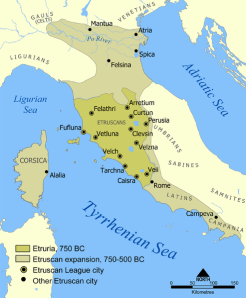
The early Roman Republic was just a local Italian power and nothing to be feared or worried about…yet.
Zach – Mulan, can you enlighten us on the nature of the Greek forces?
Mulan – Of course. The Greeks under Pyrrhus used a more traditional phalanx than Alexander the great. They had large blocks of heavy infantry with heavy shields and very long pikes. They moved as one unit and lumbered forward. The Greeks at this time did have more archers and cavalry than in more ancient times, such as at Marathon. The phalanx fought as a moving wall of spiky death. With the long fifteen foot long pikes and giant shields, they weren’t maneuverable. But as long as you’re in front of it, you’re going to die. As the phalanx moved forward like a bad spiked wall in a spy movie, the cavalry would attack from the sides. Also, Pyrrus brought war elephants.
Zach – The Greek city of Tarentum in Italy was having problems with their Roman neighbors so they asked their Greek Cousin, Pyrrhus for some reinforcements. Pyrrhus, seeing an opportunity to snatch some more land, gladly agreed and sent an army of 25,000 men into Italy. Pyrrhus had the idea that the conquered tribes would join them and rebel against Rome. But when he arrived he found the locals were actually happy to be Romans. (A mistake Hannibal would make.)
Olga – They like not being filthy barbarians!
Ann – Sure. That’s a simplistic way to view it.
Boudica – Some of us prefer to be “filthy barbarians.” Better filthy than enslaved by tyranny.
Mulan – The Romans didn’t like a foreign power moving in on Italy and sent an army to deal with them. This was the first battle of Phalanx vs. Legion.
Mulan – During the battle near Heraclea, one of the war elephants was wounded and went berserk making the other elephants go crazy, cancelling out any advantage they could have given. That is not satisfactory. Despite this, Pyrrhus sucked it up and won the battle. But he took so many casualties that he could barely call it a victory.
Martel – The Romans were great at one thing in particular: coming back from a huge loss. They sent another army. The Romans trained certain troops to counter the elephants with fire and spears. They also set up in woods to counter the Greek elephants and cavalry. The battle lasted two day and during the first day the Greeks couldn’t dislodge the Romans from the woods. The elephants didn’t see action that day. On the second day, the Greeks managed to force the Romans out by taking the high ground and they fought a huge battle where army lined up against army.
Olga – Elephants! Pyrrhus sent elephants but Romans no stop elephants and elephants run through legion stomping on peoples.
Boudica – Ha! Serves those Roman pigs right! The Roman army broke and fled. I wish I had a few elephants.
Zach – Yes, Pyrrhus won, but he lost too many troops that he couldn’t afford to lose. He was quoted as saying “One more such victory, and we shall be undone.” He won the battles but lost the war. He was eventually forced to go back to Greece. Though Rome was just a small, emerging power, they showed that even in defeat they could lay down a whooping. Pyrrhus offered terms of peace but the Romans said “Forget it, pal! No peace until you beat feet out of Italy!” And the war continued. So the Romans allied with the Carthaginians (who they’d later fight) and fought the Greeks again.
Anna – I do like this part. The town they fought at was called “Maleventum” which meant “Bad Event.”
Mulan – This time the Romans knew how to stop the elephants by wounding them in the sides and causing them to rampage in their own lines.
Anna – The Romans won the battle and renamed the town “Beneventum” which means “Good Event.”
Zach – The Roman Legions adapted and used their superior maneuverability to defeat a superior force. That was the strength of the Legion vs the Phalanx, adaptability. Once a phalanx was outmaneuvered, there was little it could do but be destroyed, a fact that would later be proved when Rome invades Greece later on in history.
Martel – After this, Pyrrhus has had enough and leaves Italy for good, having accomplished nothing. He then said “What a battlefield I am leaving for Carthage and Rome!” Predicting the future conflict between Rome and Carthage.
Boudica – Oh. wonderful. A Roman victory. How joyous.
Olga – Poor little elephants.
Gaspar – Don’t worry. They were cyborg elephants so they didn’t feel any pain.
Zach – This victory over Pyrrhus showed the Mediterranean world that Rome was going to be a player. Their power in Italy was cemented and they leveled up and became a level 5 warlike government.
Olga – Poor Pyrrhus. He won but got butt kicked.
Gaspar – A Pyrrhic victory, huh? He shoulda saw that coming!


